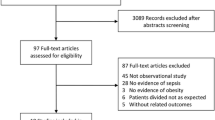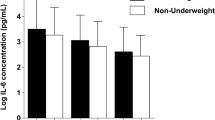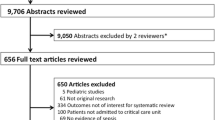Abstract
Sepsis is a major cause of hospital admissions and mortality. Nevertheless, there are significant gaps in our knowledge of the epidemiology of sepsis in obese people, who now represent more than one-third of the population in the United States. The objective of this study was to measure the association between obesity and mortality from presumed sepsis. A retrospective cohort study was used of 1,779 adult inpatients with presumed sepsis at a Tertiary Care Academic Institution from March 1, 2007 to June 30, 2011. Cases of sepsis were identified using a standardized algorithm for sepsis antibiotic treatment. Exposure (i.e., obesity) was defined as a body mass index ≥30 kg/m2. Multivariable logistic regression was used to assess the adjusted association between obesity and mortality. Patients with presumed sepsis were of a median age of 60.9 years (interquartile range 49.7–71) and 41.1 % were women. A total of 393 patients died, resulting in a 28-day in-hospital mortality of 22.1 %. In adjusted analysis, obesity was not significantly associated with increased mortality (odds ratio 1.11, 95 % CI 0.85–1.41, P = 0.47). There was also no difference in the in-hospital length of stay (P = 0.45) or maximum percent change in serum creatinine (P = 0.32) between obese and non-obese patients. Finally, there was no difference in the proportion of initial inadequate vancomycin levels (P = 0.1) after presumed sepsis. Obesity was not associated with increased mortality in patients with presumed sepsis. Further research is needed to determine how excess adiposity modulates inflammation from sepsis.

Similar content being viewed by others
References
Angus DC, Wax RS (2001) Epidemiology of sepsis: an update. Crit Care Med 29(7 Suppl):S109–S116
Lagu T, Rothberg MB, Shieh MS, Pekow PS, Steingrub JS, Lindenauer PK (2012) Hospitalizations, costs, and outcomes of severe sepsis in the United States 2003 to 2007. Crit Care Med 40(3):754–761
Martin GS, Mannino DM, Eaton S, Moss M (2003) The epidemiology of sepsis in the united states from 1979 through 2000. N Engl J Med 348(16):1546–1554
Flegal KM, Carroll MD, Kit BK, Ogden CL (2012) Prevalence of obesity and trends in the distribution of body mass index among US adults, 1999–2010. JAMA 307(5):491–497
Singer G, Stokes KY, Terao S, Granger DN (2009) Sepsis-induced intestinal microvascular and inflammatory responses in obese mice. Shock 31(3):275–279
Garey KW, Pai MP, Suda KJ et al (2007) Inadequacy of fluconazole dosing in patients with candidemia based on Infectious Diseases Society of America (IDSA) guidelines. Pharmacoepidemiol Drug Saf 16(8):919–927
Hall RG, Payne KD, Bain AM et al (2008) Multicenter evaluation of vancomycin dosing: emphasis on obesity. Am J Med 121(6):515–518
Chen M, Nafziger AN, Drusano GL, Ma L, Bertino JS Jr (2006) Comparative pharmacokinetics and pharmacodynamic target attainment of ertapenem in normal-weight, obese, and extremely obese adults. Antimicrob Agents Chemother 50(4):1222–1227
Newman D, Scheetz MH, Adeyemi OA et al (2007) Serum piperacillin/tazobactam pharmacokinetics in a morbidly obese individual. Ann Pharmacother 41(10):1734–1739
Dossett LA, Heffernan D, Lightfoot M et al (2008) Obesity and pulmonary complications in critically injured adults. Chest 134(5):974–980
Gong MN, Bajwa EK, Thompson BT, Christiani DC (2010) Body mass index is associated with the development of acute respiratory distress syndrome. Thorax 65(1):44–50
Akinnusi ME, Pineda LA, El Solh AA (2008) Effect of obesity on intensive care morbidity and mortality: a meta-analysis. Crit Care Med 36(1):151–158
El-Solh A, Sikka P, Bozkanat E, Jaafar W, Davies J (2001) Morbid obesity in the medical ICU. Chest 120(6):1989–1997
Bochicchio GV, Joshi M, Bochicchio K, Nehman S, Tracy JK, Scalea TM (2006) Impact of obesity in the critically ill trauma patient: a prospective study. J Am Coll Surg 203(4):533–538
Kalfarentzos FE, Dougenis DV, Cristopoulos DC, Spiliotis JD, Williams M, Androulakis J (1987) Prognostic criteria in intra-abdominal sepsis. Int Surg 72(3):185–187
Wurzinger B, Dunser MW, Wohlmuth C et al (2010) The association between body-mass index and patient outcome in septic shock: a retrospective cohort study. Wien Klin Wochenschr 122(1–2):31–36
Arabi YM, Dara SI, Tamim HM et al (2013) Clinical characteristics, sepsis interventions and outcomes in the obese patients with septic shock: an international multicenter cohort study. Crit Care 17(2):R72
Lautenbach E, Synnestvedt M, Weiner MG et al (2009) Epidemiology and impact of imipenem resistance in Acinetobacter baumannii. Infect Control Hosp Epidemiol 30(12):1186–1192
Lautenbach E, Weiner MG, Nachamkin I, Bilker WB, Sheridan A, Fishman NO (2006) Imipenem resistance among Pseudomonas aeruginosa isolates: risk factors for infection and impact of resistance on clinical and economic outcomes. Infect Control Hosp Epidemiol 27(9):893–900
Rattanaumpawan P, Morales KH, Binkley S et al (2011) Impact of antimicrobial stewardship programme changes on unnecessary double anaerobic coverage therapy. J Antimicrob Chemother 66(11):2655–2658
Bone RC, Balk RA, Cerra FB et al (1992) Definitions for sepsis and organ failure and guidelines for the use of innovative therapies in sepsis. The ACCP/SCCM consensus conference committee. American college of chest Physicians/Society of critical care medicine. Chest 101(6):1644–1655
Falagas ME, Athanasoulia AP, Peppas G, Karageorgopoulos DE (2009) Effect of body mass index on the outcome of infections: a systematic review. Obes Rev 10(3):280–289
WHO Expert Committee (1995) Physical status: the use and interpretation of anthropometry. WHO Technical Report Series No. 854. WHO, Geneva
Rybak MJ, Lomaestro BM, Rotschafer JC et al (2009) Therapeutic monitoring of vancomycin in adults summary of consensus recommendations from the American society of health-system pharmacists, the infectious diseases society of America, and the society of infectious diseases pharmacists. Pharmacotherapy 29(11):1275–1279
Quan H, Sundararajan V, Halfon P et al (2005) Coding algorithms for defining comorbidities in ICD-9-CM and ICD-10 administrative data. Med Care 43(11):1130–1139
Naessens JM, Campbell CR, Berg B, Williams AR, Culbertson R (2007) Impact of diagnosis-timing indicators on measures of safety, comorbidity, and case mix groupings from administrative data sources. Med Care 45(8):781–788
Hosmer DW, Lemeshow S (2000) Model building strategies and methods for logistic regression. In: Hosmer DW, Lemeshow S (eds) Applied logistic regression, 2nd edn. John Wiley & Sons, New York
Flegal KM (2007) The effects of changes in smoking prevalence on obesity prevalence in the United States. Am J Public Health 97(8):1510–1514
Huttunen R, Heikkinen T, Syrjanen J (2011) Smoking and the outcome of infection. J Intern Med 269(3):258–269
Greenland S (1996) Basic methods for sensitivity analysis of biases. Int J Epidemiol 25(6):1107–1116
Annane D, Cariou A, Maxime V et al (2010) Corticosteroid treatment and intensive insulin therapy for septic shock in adults: a randomized controlled trial. JAMA 303(4):341–348
Sprung CL, Annane D, Keh D et al (2008) Hydrocortisone therapy for patients with septic shock. N Engl J Med 358:111–124
Ranieri VM, Thompson BT, Barie PS et al (2012) Drotrecogin alfa (activated) in adults with septic shock. N Engl J Med 366:2055–2064
Levy MM, Fink MP, Marshall JC et al (2003) 2001 SCCM/ESICM/ACCP/ATS/SIS International Sepsis Definitions Conference. Crit Care Med 31(4):1250–1256
Mikkelsen ME, Miltiades AN, Gaieski DF et al (2009) Serum lactate is associated with mortality in severe sepsis independent of organ failure and shock. Crit Care Med 37(5):1670–1677
Gaieski DF, Edwards JM, Kallan MJ et al (2013) Benchmarking the incidence and mortality of severe sepsis in the United States. Crit Care Med 41(5):1167–1174
Carnahan RM, Herman RA, Moores KG (2012) A systematic review of validated methods for identifying transfusion-related sepsis using administrative and claims data. Pharmacoepidemiol Drug Saf 21(Suppl 1):222–229
Maffei M, Halaas J, Ravussin E et al (1995) Leptin levels in human and rodent: measurement of plasma leptin and ob RNA in obese and weight-reduced subjects. Nat Med 1(11):1155–1161
Yousef AA, Amr YM, Suliman GA (2010) The diagnostic value of serum leptin monitoring and its correlation with tumor necrosis factor-alpha in critically ill patients: a prospective observational study. Crit Care 14(2):R33
Gainsford T, Willson TA, Metcalf D et al (1996) Leptin can induce proliferation, differentiation, and functional activation of hemopoietic cells. Proc Natl Acad Sci USA 93(25):14564–14568
Bornstein SR, Licinio J, Tauchnitz R et al (1998) Plasma leptin levels are increased in survivors of acute sepsis: associated loss of diurnal rhythm, in cortisol and leptin secretion. J Clin Endocrinol Metab 83(1):280–283
Arnalich F, Lopez J, Codoceo R, Jimnez M, Madero R, Montiel C (1999) Relationship of plasma leptin to plasma cytokines and human survival in sepsis and septic shock. J Infect Dis 180(3):908–911
Finkielman JD, Gajic O, Afessa B (2004) Underweight is independently associated with mortality in post-operative and non-operative patients admitted to the intensive care unit: a retrospective study. BMC Emerg Med 4(1):3
Acknowledgments
A research grant from the Infectious Disease Society of America (IDSA) Medical Scholars Program supported this study.
Conflict of interest
None.
Author information
Authors and Affiliations
Corresponding author
Rights and permissions
About this article
Cite this article
Gaulton, T.G., Weiner, M.G., Morales, K.H. et al. The effect of obesity on clinical outcomes in presumed sepsis: a retrospective cohort study. Intern Emerg Med 9, 213–221 (2014). https://doi.org/10.1007/s11739-013-1002-2
Received:
Accepted:
Published:
Issue Date:
DOI: https://doi.org/10.1007/s11739-013-1002-2




